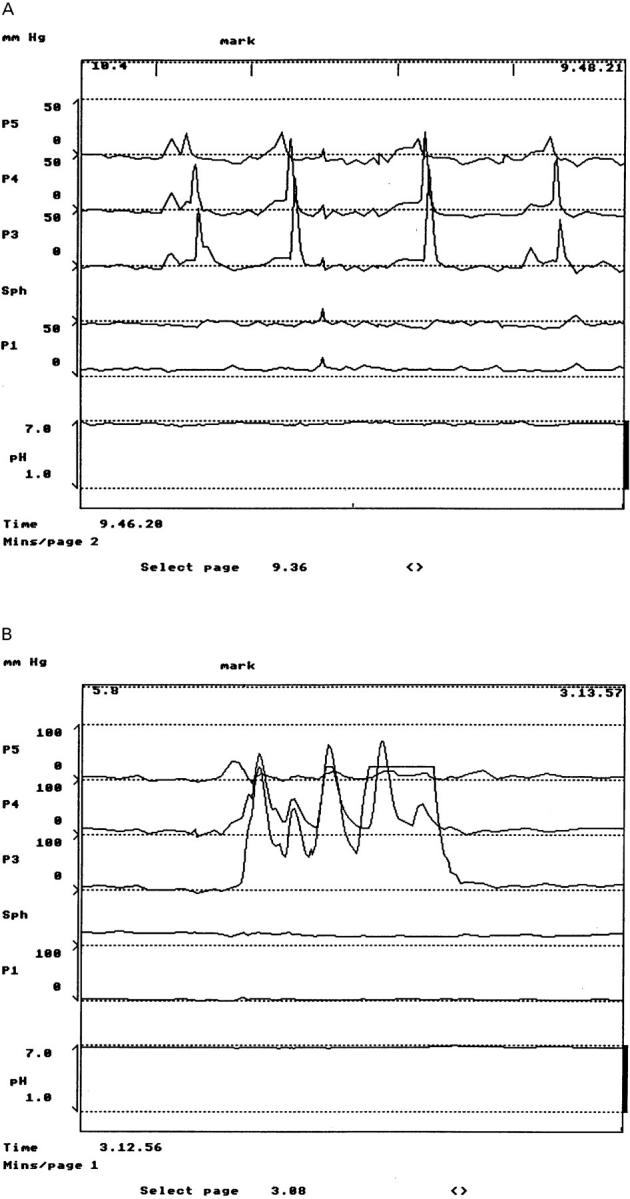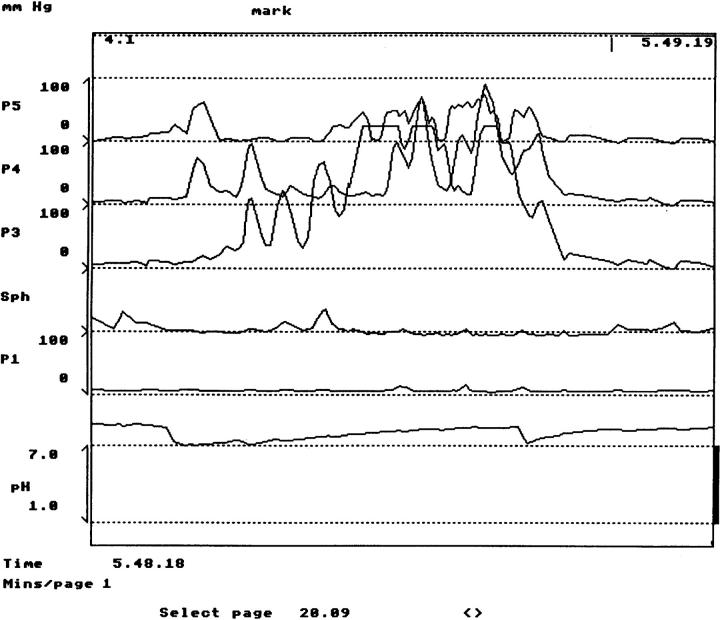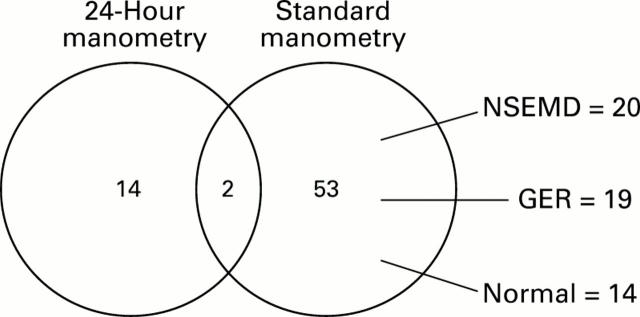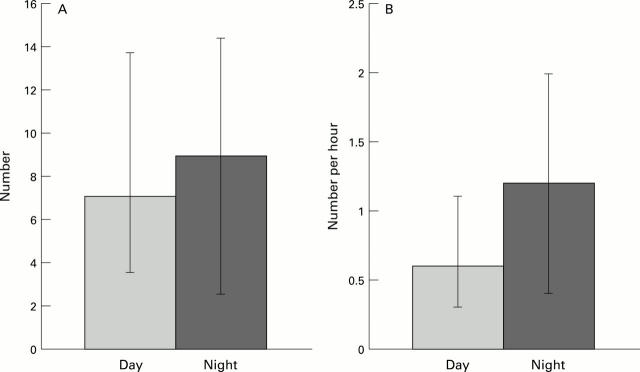Abstract
Background—Diffuse oesophageal spasm (DOS) is a potential cause of intermittent chest pain and/or dysphagia. In the past, the diagnosis of DOS has relied on criteria obtained from standard oesophageal manometry (more than one simultaneous contraction in a series of 10 wet swallows with the rest being peristaltic). As symptoms are intermittent, however, 24 hour manometry may well be more suited to its investigation. Aims—To determine the ability of 24 hour manometry to detect the symptomatic contractions of DOS and to compare standard, laboratory based manometry with 24 hour manometry in its diagnosis. Patients—Three hundred and ninety consecutive patients referred with suspected oesophageal disorders. Methods—Standard laboratory based manometry and 24 hour outpatient manometry. Results—Sixteen patients were classified by 24 hour manometry as having DOS on the basis of painful contractions (spasms) of excessive duration and increased amplitude. Laboratory based manometry failed to detect the majority of these patients with DOS (14/16), and 53/55 were incorrectly labelled as having DOS on the basis of asymptomatic manometric findings. Conclusion—The detection of symptomatic DOS requires 24 hour manometry.
Keywords: oesophagus; motility disorders; ambulatory manometry; diffuse oesophageal spasm; non-cardiac chest pain
Full Text
The Full Text of this article is available as a PDF (123.9 KB).
Figure 1 .
: Typical spasm contraction (amplitude >200 mm Hg, duration >15 seconds, multi-peaked) occurring in the oesophageal body and causing pain (note the event marks at the top). The start of the contractions appears peristaltic but due to their duration the majority of the contraction sequence is simultaneous. P3-P5, oesophageal transducers; Sph, sphinctometer; P1, gastric transducer; pH, oesophageal pH probe.
Figure 2 .
: The diagnosis of DOS by 24 hour manometry and standard laboratory based manometry.
Figure 3 .
: The number (A) and frequency (B) of spasm contractions occurring during the day and at night. Results expressed as medians and interquartile ranges. Differences were not significant.
Figure 4 .

: (A) Completely normal standard laboratory based manometry study. Note normal peristalsis to marked wet swallows. Contraction amplitudes are <100 mm Hg. (B) Typical spasm contractions of diffuse oesophageal spasm recorded during the ambulatory study of the same patient. Pressure scale in (B) is 0-100 mm Hg per channel so peak contraction amplitude of the spasm contraction is >230 mm Hg.
Selected References
These references are in PubMed. This may not be the complete list of references from this article.
- Barham C. P., Gotley D. C., Miller R., Mills A., Alderson D. Pressure events surrounding oesophageal acid reflux episodes and acid clearance in ambulant healthy volunteers. Gut. 1993 Apr;34(4):444–449. doi: 10.1136/gut.34.4.444. [DOI] [PMC free article] [PubMed] [Google Scholar]
- Benjamin S. B., Gerhardt D. C., Castell D. O. High amplitude, peristaltic esophageal contractions associated with chest pain and/or dysphagia. Gastroenterology. 1979 Sep;77(3):478–483. [PubMed] [Google Scholar]
- Browning T. H. Diagnosis of chest pain of esophageal origin. A guideline of the Patient Care Committee of the American Gastroenterological Association. Dig Dis Sci. 1990 Mar;35(3):289–293. doi: 10.1007/BF01537404. [DOI] [PubMed] [Google Scholar]
- CREAMER B., DONOGHUE E., CODE C. F. Pattern of esophageal motility in diffuse spasm. Gastroenterology. 1958 May;34(5):782–796. [PubMed] [Google Scholar]
- Cohen S. Noncardiac chest pain. The crumbling of the sphinx. Dig Dis Sci. 1989 Nov;34(11):1649–1650. doi: 10.1007/BF01540038. [DOI] [PubMed] [Google Scholar]
- Dalton C. B., Castell D. O., Hewson E. G., Wu W. C., Richter J. E. Diffuse esophageal spasm. A rare motility disorder not characterized by high-amplitude contractions. Dig Dis Sci. 1991 Aug;36(8):1025–1028. doi: 10.1007/BF01297441. [DOI] [PubMed] [Google Scholar]
- DeMeester T. R., O'Sullivan G. C., Bermudez G., Midell A. I., Cimochowski G. E., O'Drobinak J. Esophageal function in patients with angina-type chest pain and normal coronary angiograms. Ann Surg. 1982 Oct;196(4):488–498. doi: 10.1097/00000658-198210000-00013. [DOI] [PMC free article] [PubMed] [Google Scholar]
- Fleshler B. Diffuse esophageal spasm. Gastroenterology. 1967 Mar;52(3):559–564. [PubMed] [Google Scholar]
- Hewson E. G., Dalton C. B., Richter J. E. Comparison of esophageal manometry, provocative testing, and ambulatory monitoring in patients with unexplained chest pain. Dig Dis Sci. 1990 Mar;35(3):302–309. doi: 10.1007/BF01537406. [DOI] [PubMed] [Google Scholar]
- Janssens J., Vantrappen G., Ghillebert G. 24-hour recording of esophageal pressure and pH in patients with noncardiac chest pain. Gastroenterology. 1986 Jun;90(6):1978–1984. doi: 10.1016/0016-5085(86)90270-2. [DOI] [PubMed] [Google Scholar]
- Peters L., Maas L., Petty D., Dalton C., Penner D., Wu W., Castell D., Richter J. Spontaneous noncardiac chest pain. Evaluation by 24-hour ambulatory esophageal motility and pH monitoring. Gastroenterology. 1988 Apr;94(4):878–886. [PubMed] [Google Scholar]
- ROTH H. P., FLESHLER B. DIFFUSE ESOPHAGEAL SPASM; CLINICAL, RADIOLOGICAL, AND MANOMETRIC OBSERVATIONS. Ann Intern Med. 1964 Nov;61:914–923. doi: 10.7326/0003-4819-61-5-914. [DOI] [PubMed] [Google Scholar]
- Richter J. E., Wu W. C., Johns D. N., Blackwell J. N., Nelson J. L., 3rd, Castell J. A., Castell D. O. Esophageal manometry in 95 healthy adult volunteers. Variability of pressures with age and frequency of "abnormal" contractions. Dig Dis Sci. 1987 Jun;32(6):583–592. doi: 10.1007/BF01296157. [DOI] [PubMed] [Google Scholar]
- Smout A. J., Breedijk M., van der Zouw C., Akkermans L. M. Physiological gastroesophageal reflux and esophageal motor activity studied with a new system for 24-hour recording and automated analysis. Dig Dis Sci. 1989 Mar;34(3):372–378. doi: 10.1007/BF01536258. [DOI] [PubMed] [Google Scholar]
- Stein H. J., DeMeester T. R., Eypasch E. P., Klingman R. R. Ambulatory 24-hour esophageal manometry in the evaluation of esophageal motor disorders and noncardiac chest pain. Surgery. 1991 Oct;110(4):753–763. [PubMed] [Google Scholar]
- Stuart R. C., Hennessy T. P. Primary disorders of oesophageal motility. Br J Surg. 1989 Nov;76(11):1111–1120. doi: 10.1002/bjs.1800761104. [DOI] [PubMed] [Google Scholar]
- Valori R. M. Nutcracker, neurosis, or sampling bias? Gut. 1990 Jul;31(7):736–737. doi: 10.1136/gut.31.7.736. [DOI] [PMC free article] [PubMed] [Google Scholar]





